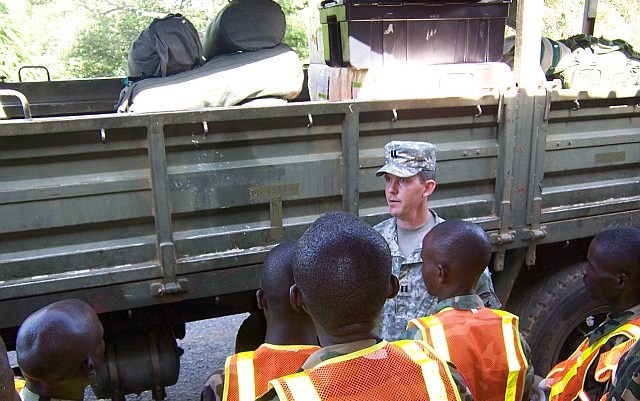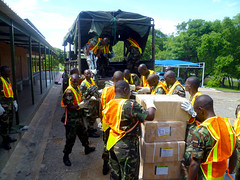Story by Rich Bartell, U.S. Army Africa Public Affairs
Photos by Capt. Brad Copas, U.S. Army Africa G-4 Logistics Directorate/Kentucky Army National Guard
Click here for the original story.
Click here for more photos.
[caption id="" align="aligncenter" width="576" caption="Kentucky Army National Guard Capt. Brad Copas is currently serving with the U.S. Army Africa’s G-4 Logistics Directorate conducting convoy training with the Malawi defense forces."]

VICENZA, Italy – As part of the African Deployment Partnership Training, three U.S. Army instructors traveled to Salima, Malawi to conduct convoy training with 22 Malawian Defense Forces, Jan. 16-20.
Capt. Brad Copas of U.S. Army Africa’s G-4 Logistics Directorate was the course facilitator and an additional instructor for the week-long training. Copas, along with Maj. Brooke Grubb and Sgt. 1st Class Brian Underwood, covered basic convoy operations, determining center of gravity for vehicles.
“The ADAPT class was the first training of this type ever for the MDF,” said Brig. Gen. Rodrick Chimowa, commandant of the Malawi Armed Forces College.
“We hope you return soon with Phase II training so that we can improve our skills and continue to support peace operations in Africa,” he said. According to Copas, the class was an eager group of both army and Air Corps soldiers.
“The class was made up of mixture of officers and non-commissioned officers from the Malawian Army and Air Corps. They picked up the information quickly and didn’t need much guidance during practical exercises,” Copas said.
[caption id="" align="alignleft" width="240" caption="Malawian soldiers work on a practical exercise during African Deployment Partnership Training in Salima, Malawi. (U.S. Army Africa photo by Capt. Brad Copas.)"]

Copas explained how the MDF used the ADAPT training to improve convoy operations. “MDF troops are accustomed to conducting convoy and deployment operations. Our Malawian partners are great students and good at adapting our training to their operations,” Copas said. “They’ve participated in United Nations peace keeping missions in the past and will likely do so again. As a result, they’ll be able to use training to enhance the convoy and deployment phases of those missions.”
Copas said his fellow instructors, Grubb and Underwood, are Army National Guardsmen who traveled from the U.S. for the ADAPT training in Malawi.
“As instructors, we reinforced that NCOs are normally primary instructors as Underwood took the lead in a lot of the instruction. We covered peacetime and conflict convoy operations, load plans for air operations as well as unit movement planning,” Copas said.
An example of their ability to adapt occurred when instructors and students were covering a load plan for air shipment practical exercise.
“We didn’t have a specialized 463L pallet [used for transporting military air cargo]; however, we found a local pallet that performed well. We put our heads together and improvised,” Copas said.
He praised MDF students for their professionalism and academic excellence.
“All of our students performed at a high level. You couldn’t ask much more from students. They caught on quickly and require little guidance during practical exercises. They are receptive and appreciative learners. Without hesitation, I would say that all of the students would be successful unit movement officers,” Copas said.